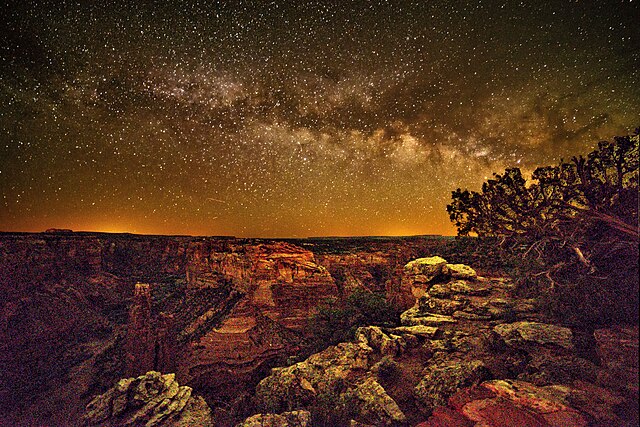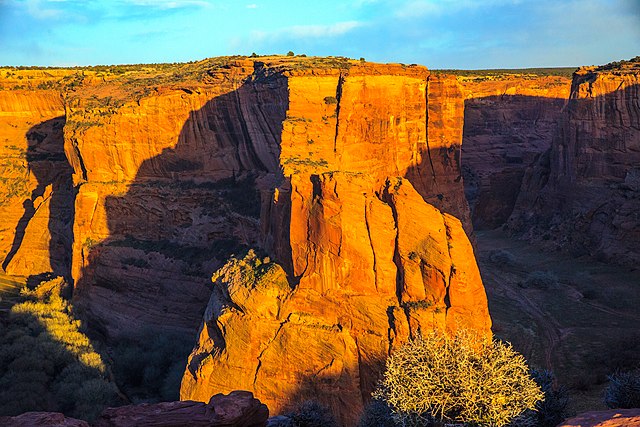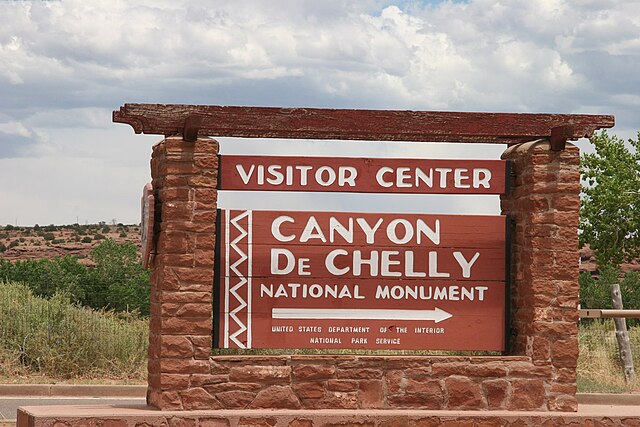Have you ever wondered what it would be like to step back in time and walk among ancient civilizations? Canyon de Chelly National Monument in northeastern Arizona offers exactly that experience. This remarkable destination isn’t just another pretty landscape – it’s a living testament to thousands of years of human history, where ancient ruins nestle against towering red sandstone walls and Navajo families continue traditions passed down through generations.
What Makes Canyon de Chelly National Monument Special?
Canyon de Chelly (pronounced “de-SHAY”) stands apart from other national monuments for one crucial reason: it’s still home to people. Unlike many archaeological sites that feel frozen in time, this canyon pulses with life as Navajo families continue to farm, herd sheep, and maintain their ancestral connections to this sacred land.
A Living Cultural Landscape
What sets Canyon de Chelly apart is its unique status as both a national monument and a place where people actually live. The National Park Service manages the monument jointly with the Navajo Nation, creating a partnership that honors both preservation and cultural continuity. This means you’re not just viewing history – you’re witnessing it in action.
The canyon system stretches for about 84 square miles, encompassing three major canyons: Canyon de Chelly, Canyon del Muerto, and Monument Canyon. Each offers its own distinct personality and attractions, but all share the same breathtaking beauty of red sandstone walls rising up to 1,000 feet above the canyon floor.
Geological Wonder Millions of Years in the Making
The dramatic landscape you see today began forming around 230 million years ago during the Triassic period. Layer upon layer of sediment built up over millions of years, creating the distinctive red and white striped walls we see today. The meandering Chinle Wash carved these canyons over millennia, exposing geological history in stunning vertical displays.
Those towering walls aren’t just beautiful – they’re like pages in Earth’s history book. The red layers contain iron oxide, giving them their distinctive rust color, while the white and tan bands represent different periods of sediment deposition. It’s geology you can actually see and appreciate without needing a PhD to understand it.
The Rich History of Canyon de Chelly

Ancient Puebloan Heritage
The story of human habitation in Canyon de Chelly begins around 2,500 years ago with the Basketmaker people, followed by the Ancient Puebloans (formerly called Anasazi). These skilled builders created the cliff dwellings and ruins that draw thousands of visitors today.
The most famous of these ruins is the White House, built around 1060 CE. This remarkable structure showcases the architectural ingenuity of the Ancient Puebloans, who somehow managed to construct multi-story buildings on seemingly impossible cliff faces. How did they do it? They used natural ledges and alcoves in the canyon walls, creating structures that have weathered nearly a thousand years.
Spanish Colonial Period
Spanish explorers first entered the canyon in 1805, led by Lieutenant Antonio Narbona. The Spanish influence is still visible today in the canyon’s name – “de Chelly” comes from the Navajo word “tséyiʼ,” meaning “rock canyon,” which the Spanish adapted to their own language.
This period brought significant changes to the canyon’s inhabitants. The Spanish introduced new crops, livestock, and technologies, but also brought conflict and disease that dramatically impacted Native populations.
The Navajo people began settling in Canyon de Chelly around 1700 CE, and their presence has been continuous ever since. This isn’t just a place they visit – it’s home. Navajo families maintain traditional hogans, tend sheep and cattle, and grow crops on the fertile canyon floor.
Today, about 40 Navajo families live within the monument boundaries, primarily during the warmer months. They practice traditional farming methods, growing corn, beans, and squash – the same crops their ancestors cultivated centuries ago. You might see their livestock grazing near ancient ruins, creating a powerful visual connection between past and present.
The Navajo consider Canyon de Chelly sacred, and many of their traditional stories and ceremonies are connected to specific locations within the canyon. Spider Rock, for example, plays a central role in Navajo creation stories and is considered the home of Spider Grandmother, a revered figure in Navajo mythology.
Exploring the Canyon: Main Attractions

Spider Rock: The Iconic Landmark
Rising 800 feet from the canyon floor, Spider Rock is Canyon de Chelly’s most photographed landmark. This towering sandstone spire looks like something from another planet, especially when bathed in the golden light of sunrise or sunset.
According to Navajo legend, Spider Rock is the home of Spider Grandmother, who taught the Navajo people how to weave. The white cap on top of the rock is said to be the bleached bones of children who misbehaved – a traditional cautionary tale that’s both beautiful and slightly terrifying.
White House Ruins Trail
The White House Ruins Trail offers the only self-guided hiking opportunity that descends into the canyon. This 2.5-mile round trip hike takes you down 600 feet to the canyon floor, where you can view the White House ruins up close.
The trail winds through diverse ecosystems, from piñon pine and juniper on the rim to cottonwoods and willows near the wash. Along the way, you’ll pass through a tunnel in the rock and experience the canyon from ground level – a perspective that’s dramatically different from the rim views.
Antelope House Overlook
Antelope House gets its name from the beautiful antelope pictographs painted on the cliff walls by Navajo artists in the 1830s. The ruins themselves date back to 693 CE, making them some of the oldest in the canyon.
This overlook provides excellent views of the ruins and is particularly spectacular during golden hour when the red rocks seem to glow from within. The site also offers interpretive information about the various cultures that called this place home.
Best Photography Spots
For photographers, Canyon de Chelly offers endless opportunities. The changing light throughout the day creates dramatically different moods and colors. Early morning and late afternoon provide the best lighting for both landscape and architectural photography.
Consider bringing a telephoto lens to capture details of the ruins and rock formations. The interplay of light and shadow on the canyon walls creates stunning compositions, especially during the “blue hour” just after sunset.
Visiting Canyon de Chelly: Planning Your Trip
When to Visit: Seasonal Considerations
Canyon de Chelly is beautiful year-round, but each season offers different advantages. Spring (April-May) brings wildflowers and mild temperatures, perfect for hiking and photography. Summer (June-August) can be hot during the day but offers long hours of daylight for exploration.
Fall (September-November) might be the best time to visit, with comfortable temperatures, clear skies, and fewer crowds. Winter (December-March) can be cold and snowy, but the snow-covered red rocks create a magical landscape that few visitors experience.
Getting There and Transportation
The monument is located in Chinle, Arizona, on the Navajo Nation. The closest major city is Flagstaff, about 220 miles away. The drive takes you through some of Arizona’s most beautiful landscapes, including sections of the Painted Desert.
Driving Directions from Major Cities
From Phoenix: Take I-17 north to Flagstaff, then US-89 north to US-160 east to US-191 north to Chinle. The total drive is about 350 miles and takes roughly 5.5 hours.
From Albuquerque: Take I-40 west to US-191 north to Chinle. This route is about 220 miles and takes approximately 3.5 hours.
The roads are generally good, but be prepared for some winding mountain sections and check weather conditions in winter.
Tours and Activities
The only way to explore the canyon floor (except for the White House Trail) is with a Navajo guide. These tours are absolutely worth it – your guide will share stories, point out details you’d miss on your own, and provide cultural context that brings the canyon to life.
Tours range from half-day trips to multi-day camping adventures. Some guides use traditional horse-drawn wagons, while others prefer modern vehicles. Many guides are members of families who have lived in the canyon for generations, offering authentic insights into both history and contemporary life.
Self-Guided Rim Drives
Two scenic drives offer spectacular views without requiring a guide. Both are suitable for most vehicles and provide numerous pullouts and overlooks.
North Rim Drive Highlights
The North Rim Drive (Canyon del Muerto) is 34 miles round trip and includes stops at Ledge Ruin Overlook, Antelope House Overlook, and Mummy Cave Overlook. Each stop offers different perspectives on the canyon’s geological and cultural history.
Mummy Cave, at the end of the drive, contains ruins from multiple time periods, showing how different cultures adapted and used the same spaces over centuries.
South Rim Drive Must-Sees
The South Rim Drive covers 36 miles round trip and includes the famous Spider Rock Overlook, White House Overlook, and Sliding House Overlook. This drive tends to be busier than the North Rim, especially during peak season.
The White House Overlook provides the best view of the canyon’s most accessible ruins and serves as the trailhead for the only self-guided hike into the canyon.
Accommodation and Dining Options
Where to Stay Near the Monument
Accommodation options near Canyon de Chelly range from basic to comfortable, though luxury resorts aren’t part of the landscape here. The Thunderbird Lodge, located right at the monument entrance, offers comfortable rooms and is the only lodging actually within the monument boundaries.
In Chinle, you’ll find several chain hotels and motels that provide clean, comfortable accommodations. For a more authentic experience, consider staying at one of the Navajo-owned bed and breakfasts in the area.
Local Dining Experiences
Dining options are somewhat limited but include opportunities to try traditional Navajo cuisine. The Thunderbird Lodge restaurant serves both American and Navajo dishes, including fry bread and mutton stew.
In Chinle, you’ll find a mix of fast food chains and local restaurants. Don’t miss the chance to try authentic Navajo tacos – fry bread topped with beans, meat, lettuce, and tomatoes.
Photography Tips for Canyon de Chelly

Best Times for Golden Hour Shots
The canyon’s orientation means that different overlooks are best at different times of day. Spider Rock is spectacular at sunset, while the White House ruins look best in the morning light. Plan your photography schedule around these natural lighting patterns.
Consider the seasonal angle of the sun as well. Winter light penetrates deeper into the canyon, while summer light creates more dramatic shadows and contrasts.
Equipment Recommendations
A sturdy tripod is essential for low-light photography and long exposures. Bring extra batteries, as cold weather can drain them quickly. A polarizing filter can help reduce glare from the red rocks and enhance color saturation.
For smartphone photographers, consider bringing a portable phone tripod and experimenting with HDR settings to capture the full range of light and shadow in the canyon.
Cultural Etiquette for Visitors
Remember that Canyon de Chelly is a sacred place for the Navajo people and a working landscape where families live and farm. Always stay on designated trails and respect private property. Never touch or disturb ruins, artifacts, or rock art.
Photography of Navajo people, their homes, or ceremonies requires permission. When in doubt, ask first. Many Navajo guides and residents are happy to share their culture with respectful visitors.
Supporting Local Communities
Your visit can directly benefit local Navajo families. Hire local guides, buy authentic crafts from local artisans, and eat at Navajo-owned restaurants. This helps ensure that tourism benefits the people who call this place home.
Many overlooks have vendors selling authentic Navajo jewelry, pottery, and textiles. These aren’t just souvenirs – they’re works of art created by skilled artisans using traditional methods.
Wildlife and Natural Features
Flora and Fauna of the Canyon
The canyon’s diverse ecosystems support a variety of wildlife. You might spot mule deer, elk, black bears, and numerous bird species. The canyon floor supports different vegetation than the rim, creating distinct microhabitats.
Cottonwood trees line the wash, providing shade and habitat for birds and small mammals. The rim country features piñon pine, juniper, and various desert plants adapted to the high desert climate.
Seasonal Wildlife Viewing
Spring and fall offer the best wildlife viewing opportunities. Birds are most active during migration periods, and mammals are more visible when temperatures are moderate. Early morning and late afternoon are prime times for wildlife observation.
Keep your distance from all wildlife and never feed wild animals. Bears, though rare, do inhabit the area, so proper food storage is important if you’re camping.
Conclusion
Canyon de Chelly National Monument offers something truly special – a chance to experience living history in one of America’s most beautiful landscapes. This isn’t just a destination; it’s a journey through time where ancient ruins stand alongside modern Navajo life, where geological wonders tell stories spanning millions of years, and where every overlook offers a new perspective on the enduring connection between people and place.
Whether you’re drawn by the photography opportunities, the hiking trails, the cultural experiences, or simply the chance to witness something extraordinary, Canyon de Chelly delivers on all fronts. It’s a place that changes you, that makes you think differently about history, culture, and the land itself.
Plan your visit with respect, come with an open mind, and prepare to be amazed. Canyon de Chelly isn’t just another stop on your Arizona itinerary – it’s a destination that will stay with you long after you’ve returned home.
Frequently Asked Questions
Q: Do I need a permit to visit Canyon de Chelly National Monument?
A: No permit is required to visit the rim drives and overlooks. However, you need a Navajo guide for any travel into the canyon itself (except for the White House Trail). The monument is free to enter.
Q: Can I camp in Canyon de Chelly?
A: Yes, Cottonwood Campground near the visitor center offers first-come, first-served camping sites. Backcountry camping in the canyon requires a permit and Navajo guide. The campground has restrooms and picnic tables but no hookups.
Q: How long should I plan for my visit?
A: A minimum of two days allows you to drive both rim roads and take the White House Trail. Three to four days gives you time for a guided canyon tour and more thorough exploration of the overlooks. Photography enthusiasts might want even more time to capture different lighting conditions.
Q: Are the rim drives suitable for RVs?
A: Yes, both rim drives can accommodate RVs and trailers, though some overlook parking areas may be tight for very large vehicles. The roads are paved and well-maintained, making them accessible for most vehicles.
Q: What should I bring for a visit to Canyon de Chelly?
A: Bring plenty of water, sunscreen, a hat, and comfortable walking shoes. Weather can change quickly, so dress in layers. Don’t forget your camera and binoculars for wildlife viewing. If hiking the White House Trail, bring snacks and extra water.

